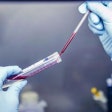
Changes in C-reactive protein (CRP) in the early days of hospital admission for COVID-19 help pinpoint those most at risk of going downhill with bad outcomes and treat them accordingly, Brigham and Women's Hospital researchers reported on October 29 in Cell Reports Medicine.
As a marker of inflammation, CRP testing has been of high interest for assessment of COVID-19, along with other lab measures. However, the new study focused on the change in CRP in the first few days of hospital admission as opposed to a single value when patients first arrived.
The retrospective study of 100 patients at Brigham and Women's found that a rising CRP in the first 48 hours correlated more strongly with respiratory decline than CRP at baseline or the respiratory rate-oxygenation (ROX) index, a bedside calculation used for assessing respiratory function.
"Our study suggests that examination of dynamic trends, rather than absolute value at admission, can lead to strong associations with prognosis despite only using a single laboratory value," Brigham and Women's pulmonologist Dr. Edy Yong Kim, PhD, and colleagues wrote.
In a statement about the data, Kim said that the rate of change in the first three days is a "very powerful and very clinically predictive test," and noted that Brigham and Women's had already changed protocols based on the data.
"This metric is feasible for frontline clinicians in the emergency department observation units or medical floor inpatient wards," the authors wrote.
Researchers undertook the study to determine if there was a way to improve risk stratification of COVID-19 patients who are not in critical condition and have mild oxygen needs at the time they are admitted to the hospital. It's been unclear which of these patients will remain stable and which will deteriorate and go on to need mechanical ventilation and other intensive treatment measures. Patients who are more at risk could be watched closely to improve clinical outcomes.
Elevated CRP at the time of admission doesn't help discriminate between those who will stay in a mild state versus those who will progress to respiratory failure, the authors explained. Kim et al see value in dividing patients into three categories based on biomarker values. The mortality rate in the study was 24% overall, with much poorer outcomes for those in progressive and severe categories.
Change in CRP was more sensitive and specific on a statistically significant basis than baseline CRP, as well as the ROX index in the early days after admission.
"Remarkably, we found that a rise in CRP values over the first 48-72 [hours] of hospital admission distinguished patients who would develop progressive respiratory failure from patients who would remain stable throughout their hospital course," the authors wrote.
| Performance of CRP for risk prediction in COVID-19 patients | ||
| Baseline CRP mg/dL | Change in CRP mg/L | |
| Sensitivity | 0.45 | 0.90 |
| Specificity | 0.91 | 0.62 |
| Positive predictive value | 0.59 | 0.73 |
| Negative predictive value | 0.73 | 0.86 |
In addition to CRP, those who went on to have progressive disease had higher D-dimer levels, and elevations in procalcitonin and interleukin 6 (IL-6), the authors also noted. CRP levels are linked to IL-6 signaling and there was a "striking correlation" between the two measures in a subset of patients for whom IL-6 data were available.
"In many institutions, CRP levels result within several hours and can capture rapidly evolving clinical courses that cytokine assays, which take more than 1 to 2 days, cannot," the authors noted.
The authors suggested that patients with a rapid elevation in CRP may be candidates for treatment with IL-6 inhibitors and other immunomodulatory therapies, though study results for these drugs in COVID-19 have been mixed to date. In a subset treated with the IL-6 inhibitor tocilizumab (Roche's Actemra), there was a "rapid and sustained decrease in CRP levels."
"Our work may suggest that there is value in delineating the particular progressive patients whose uptrend in CRP may suggest that they could be particularly poised to benefit from this type of IL-6-directed therapy," they wrote.



















